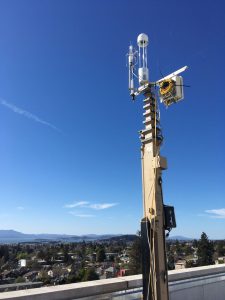The Science:
Cities have a complex mix of land uses, from commercial districts with dining and shops to residential neighborhoods linked by travel corridors, as well as industrial areas such as ports and factories. All of these different land uses lead to a diversity of urban sources that emit volatile organic compounds (VOCs) and greenhouse gasses such as carbon dioxide (CO2) and methane (CH4). VOC emissions lead to ozone and secondary organic aerosol production, which are prominent air pollutants, while CO2 and CH4 emissions drive climate change by absorbing solar radiation. Direct measurements and analysis of these species over time helps us understand human interactions with climate and air pollution.

Extended eddy covariance tower on rooftop in downtown Berkeley, CA. San Francisco Bay on the horizon.
The Impact:
Urban landscapes are highly heterogeneous and their emissions have a much greater spatial and temporal variation compared to natural ecosystems. Carbon fluxes from natural landscapes are dominated by plant photosynthesis and ecosystem respiration, processes that are driven by available light, energy, and water. On the other hand, urban fluxes will be a mix of emissions from vehicles, buildings, plants, and microorganisms with varied spatial and temporal patterns. Although VOC emissions from vehicles have decreased significantly due to regulatory efforts, many cities still experience high ozone and particulate matter air pollution, which have negative health and ecosystem consequences. As vehicles’ relative contribution to VOC emissions and pollutant formation has declined, it is of great interest to explore and identify the prominent VOC sources over time.
For example, colder weather will increase emissions from heating buildings. Commuting hours at the start and end of a typical workday will increase emissions from vehicles–but only during weekdays. Urban planning strategies strive to manage air quality and to reduce climate change. To meet those goals, we need an accurate estimation and understanding of the emission budgets of VOC, CO2, and CH4 from urban environments.
Some questions that drive our research are:
- What are the local emissions?
- What is our exposure to air pollutants in the city?
- How can we breathe cleaner air?
- How can we minimize our climate impact?
- Are policies to manage the emissions working?
Summary:
Evaluating the fluxes of urban volatile organic compounds (VOCs) and greenhouse gasses like CO2 and CH4 are important for accurately preventing air pollution and understanding climate change. Long-term continuous flux measurements of these gasses in urban areas can provide a direct understanding of how a city is approaching its goals for greenhouse gas and VOC reduction over time. Additionally, flux measurements of VOCs can improve the accuracy of emissions inventories, which are central to atmospheric models that inform air quality policy.
For three months in spring 2022, scientists at University California – Berkeley will measure fluxes of VOCs, CO2 and CH4 from the roof of a 9-story campus building (Berkeley Way West) in downtown Berkeley, California, and evaluate results to determine the feasibility of using this particular location for long-term urban flux measurements.
The Atmospheric Chemistry and Biogeochemistry Lab (PI: Allen Goldstein) will be deploying a proton transfer reaction time of flight mass spectrometer, the Vocus PTR-ToF-MS, to measure hundreds of different VOCs at 10 Hz for flux measurements. In collaboration, the Biometeorology Lab (PI: Dennis Baldocchi) will deploy an eddy covariance system to measure CO2 and CH4 fluxes. The LI-COR LI-7700 analyzer was loaned by the AmeriFlux Management Project as part of the AmeriFlux Year of Methane (https://ameriflux.lbl.gov/year-of-methane/year-of-methane/) which allows research teams to take advantage of unique research opportunities such as this project.
Contacts:
| Allen Goldstein
Department of Environmental Science, Policy, and Management, University of California, Berkeley Department of Civil and Environmental Engineering, University of California, Berkeley Email: ahg@berkeley.edu |
Dennis Baldocchi
Department of Environmental Science, Policy, and Management, University of California, Berkeley Email: baldocchi@berkeley.edu
|
Funding:
This work was supported by NOAA AC4 Grant #NA20OAR4310300.





No Comments
Be the first to start a conversation